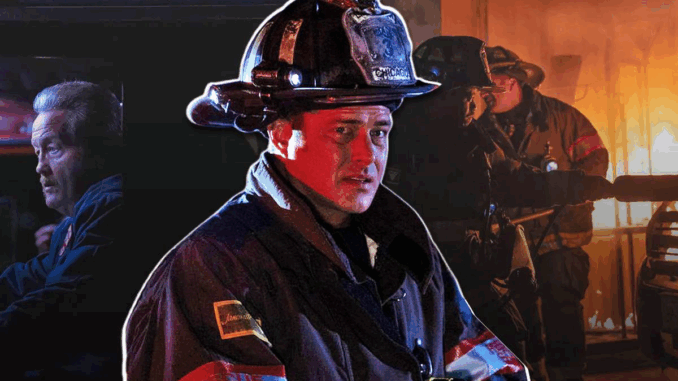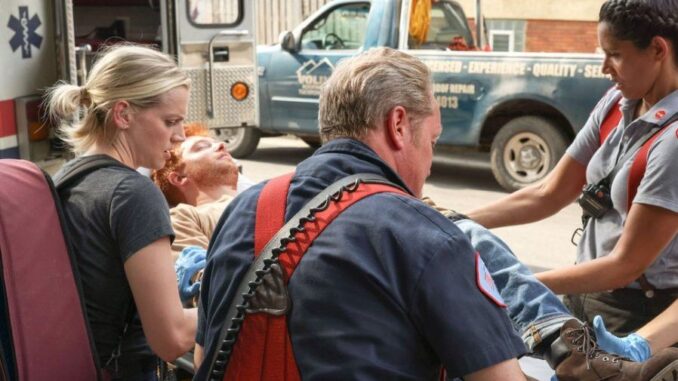
When the sirens wail and the screen erupts in flames, Chicago Fire doesn’t just show a rescue — it captures a heartbeat. The pulse of a city. The rhythm of ordinary heroes who run toward danger while the rest of the world runs away. For over a decade, NBC’s flagship drama has not merely entertained; it has endured, standing as television’s most passionate and authentic depiction of courage, sacrifice, and family.
At its core, Chicago Fire is not just a series about firefighting. It is a living, breathing chronicle of humanity under pressure — a raw, emotional exploration of what it means to serve, to lose, to love, and to rise again from the ashes. Firehouse 51 is both a battleground and a sanctuary, where flames are fought not only in burning buildings but also in the hearts of those who wear the badge.
Where Heat Meets Humanity
The brilliance of Chicago Fire lies in its duality — the heart-stopping spectacle of peril and the intimate pulse of personal storytelling. Each episode thrusts viewers into infernos so visceral you can almost feel the heat on your face, yet beneath every blaze lies a story of someone fighting for more than survival.
The show’s commitment to realism is staggering. From engulfed factories to multi-car pileups, every rescue is choreographed with cinematic precision and emotional authenticity. These sequences aren’t mere pyrotechnic displays — they are reflections of the chaos and heroism that define the firefighting world. Viewers aren’t just watching; they’re experiencing the smoke, the urgency, the impossible choices.
But the series’ true brilliance ignites when the helmets come off. Behind the uniforms are flawed, complex people grappling with grief, identity, and purpose. Lieutenant Kelly Severide (Taylor Kinney) wrestles with legacy and loss, his stoicism cracking just enough to reveal the vulnerability beneath the hero. Sylvie Brett (Kara Killmer) brings compassion and quiet strength to every call, her journey as a paramedic and adoptive mother echoing the emotional heartbeat of the show. Stella Kidd (Miranda Rae Mayo) embodies fierce determination, a woman carving her place in a world built to test her resolve. And then there’s Chief Wallace Boden (Eamonn Walker) — the soul of Firehouse 51 — whose calm authority and paternal warmth turn the station into something greater than a workplace.
A Brotherhood Forged in Fire
What makes Chicago Fire so enduring is its depiction of family. Not by blood, but by choice. Within the brick walls of Firehouse 51 exists an unspoken code of loyalty and love — one that transcends titles and ranks.
When tragedy strikes, the entire house grieves as one. When triumph arrives, they celebrate together. It’s this profound sense of unity that anchors the show through its most turbulent moments. Viewers have seen these characters fight fires, endure loss, and rebuild — both their city and themselves. Each shared meal, every inside joke, every hand on a shoulder in a moment of despair — these are the quiet embers that make Chicago Fire burn brighter than any explosion.
This portrayal of solidarity is more than aspirational television; it’s a mirror of the human condition. In an increasingly disconnected world, the show reminds us that family isn’t found — it’s forged in the crucible of shared struggle and unwavering support.
The Expanding “One Chicago” Universe
No discussion of Chicago Fire is complete without acknowledging its massive cultural impact. As the cornerstone of NBC’s One Chicago franchise, it paved the way for Chicago P.D. and Chicago Med, creating one of television’s most successful and immersive shared universes.
These crossovers do more than boost ratings — they create a sense of realism and continuity that fans crave. When detectives from Chicago P.D. arrive at a fire scene or doctors from Chicago Med battle to save a first responder’s life, the lines between shows blur beautifully, forming an intricate tapestry of interconnected heroism. It’s a testament to how Chicago Fire ignited a universe that continues to evolve and inspire.
A Legacy That Burns Bright
In an era of fleeting TV trends and streaming experiments, Chicago Fire stands tall — not because it constantly reinvents itself, but because it never forgets what it’s truly about: people. The show doesn’t glamorize the uniform; it humanizes it. It portrays firefighters not as invincible icons, but as fragile, determined souls driven by duty and compassion.
Each season builds on a foundation of authenticity and emotional resonance that has kept fans returning year after year. Its longevity is not luck — it’s legacy. The writers, cast, and crew have crafted something rare: a procedural that feels profoundly personal.

The Heart Still Burns
After more than a decade, Chicago Fire continues to capture the essence of what it means to be human in the face of chaos. It’s not just a show about saving lives — it’s about living them fully, fearlessly, and together.
In every alarm bell, in every whispered goodbye, in every ember of hope that refuses to die, Chicago Fire reminds us why we keep watching. Because at Firehouse 51, the blaze is eternal — and so is the bond.
